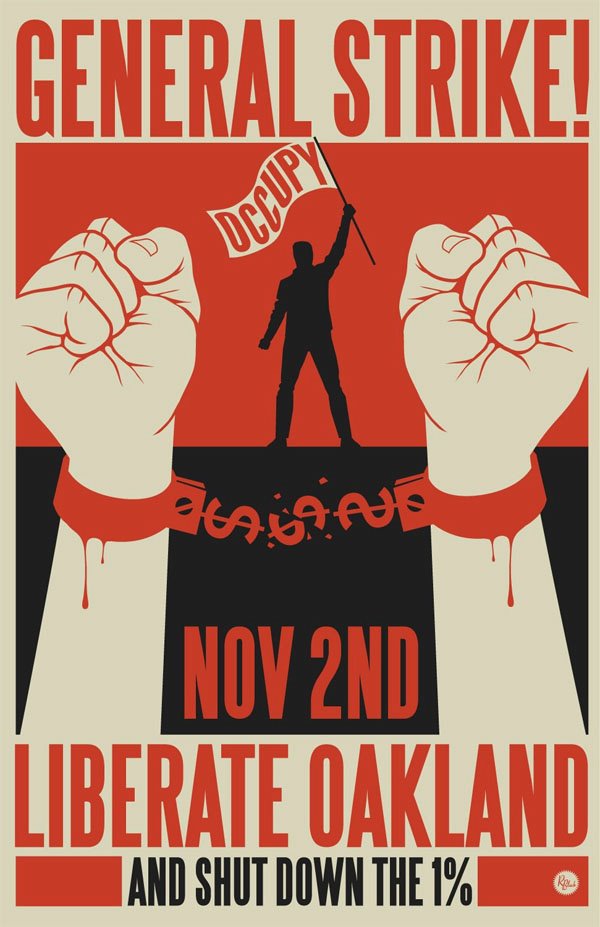The last time our nation saw a General Strike was in 1946, in Oakland. As Think Progress recounts,
Over the course of two days in December 1946, 130,000 workers in Oakland refused to work out of solidarity with a strike by 400 mostly female retail clerks in which police were intervening. Union officials called the massive strike a “worker’s holiday.” All stores but pharmacies and food markets were shut down. After two days, the general strike ended when the city government pledged police neutrality in future strikes. The retail strike continued for another five months before being resolved.
AlterNet‘s Joshua Holland, based in San Francisco, has been covering the developments at Occupy Oakland, and tells of the process leading up to today’s massive action:
At Occupy Oakland’s October 27 General Assembly, activists still sore and weary from a night of brutal police crackdowns (but also energized after re-taking the plaza from which they’d been violently evicted 36 hours before) considered whether to attempt to organize the first general strike in this country in 65 years. …
“I support a general strike right now to take advantage of this momentum,” said one speaker excitedly at the “people’s mic” that evening. “We should strike while the iron’s hot!” The sentiment was greeted by raucous applause, and the resolution passed shortly afterward.
Wednesday, November 2, was the date chosen. The strike, said activist Louise Michel at an October 31 press conference, was spurred “by a need to end police attacks on our communities, to defend our schools and libraries against closures, and against this economic system.” The occupiers, Michel continued, called for “a day of action in which the circulation of capital is blockaded, students walk out of their schools and people stage various occupations” around the city. The activists vowed to protest any businesses that keep their doors open during the strike. …
…n those five days, an enormous amount of momentum has built up behind the action. SEIU, UAW, the Alameda Labor Council – an umbrella group representing over 100 local unions – and several other locals, including two area teachers’ unions, endorsed the strike, coming as close to officially participating in the event as legally possible.
Today’s a good day to follow Joshua Holland’s twitter stream, as he’ll be tweeting from the midst of it all day.
This morning, I spoke with Alan Brill, one of the members of the Occupy Oakland media group, who gave us a bit more insight into the day’s plans and reiterating that “we need massive change in the way that our country operates.”
At the top of the show, I was joined by Vivian Richardson, a resident of the Bayview area of San Francisco. She expects to be evicted from her home on Dec. 31, after two years of trying to work out a mortgage modification with her lender, a firm based in Delaware. Just yesterday, Vivian stood alongside her former neighbor, Carolyn Craig, as she announced to the media that she and her family had reclaimed and moved back into the home they were evicted from last December.
And to finish the show, Sarah Seltzer gave us a bit more info about how things work at Occupy Wall Street. The AlterNet associate editor and NYC freelance writer penned “Where Are The Women at Occupy Wall Street? Everywhere — and They’re Not Going Away” for The Nation , and totally blew the argument of anyone who claims that the occupations aren’t structured. Being leaderless doesn’t mean disorganized. In this case, it’s quite the opposite.
Being Wednesday, I checked in with Jeremy Koulish of Main Street Insider to discuss this week’s 90 Second Summary, giving us the info we need on the Rebuild America Jobs Act”:
The first edition of The Occupied Washington Post is out. Click here to download the pdf!
And finally, you know that Occupy Wall Street is making its mark on America when South Park does a show about it. This preview from tonight’s episode:
1%
Get More: SOUTH
PARKEric Cartman,Wendy Testaburger,more…


